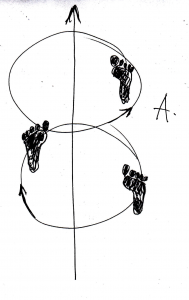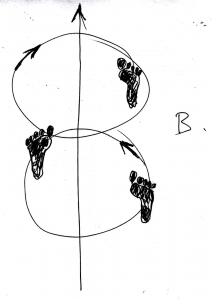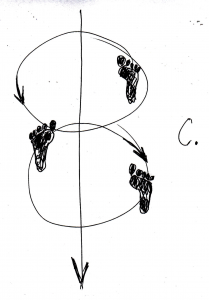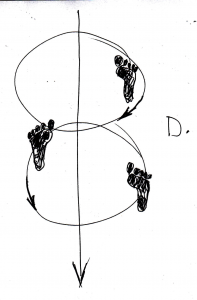The human model walking is the principle of all human movements. We distinguish between male (simple) and female (opposite) steps.
Both can be done forward and backward, so we get four basic steps that we should constantly practiced. If you understand the human walk model, you will understand all possible human movements.
One way of exploring and practicing the model (principle) of human walking is lifting hands up (see taichichuan). Another may be a bow. The bow is not only a part of social etiquette but also of all religions.
In all postures and stances, the feet are always on one and two straight lines. Thus also walking can be done on one straight line or on two straight parallel lines. Practicing walking on two straight parallel lines is more suitable for beginners as it is more slow, stable and clear. You do not need too much space to exercise basic steps.

Figure A. – Simple (male) step forward: Start from the left parallel stance and move forward into the right parallel stance. Rear (right) foot rises and moves forward and near of the front (left) foot and then step forward into the right parallel stance. The movement of the right foot describes first the concave and then the convex segment of momentum transfer of inner force.
 Figure B. – Reverse (female) step forward: Start from the left parallel stance and move forward into the right parallel stance. Rear (right) foot rises and moves forward and near of the front (left) foot and then step forward into the right parallel stance. The movement of the right foot describes first the convex and then the concave segment of momentum transfer of inner force.
Figure B. – Reverse (female) step forward: Start from the left parallel stance and move forward into the right parallel stance. Rear (right) foot rises and moves forward and near of the front (left) foot and then step forward into the right parallel stance. The movement of the right foot describes first the convex and then the concave segment of momentum transfer of inner force.
 Figure C. – Simple (male) step backward: Start from the left parallel stance and move backward into the right parallel stance. Front (right) foot rises and moves backward and near of the rear (left) foot and then step backward into the right parallel stance. The movement of the right foot describes first the convex and then the concave segment of momentum transfer of inner force.
Figure C. – Simple (male) step backward: Start from the left parallel stance and move backward into the right parallel stance. Front (right) foot rises and moves backward and near of the rear (left) foot and then step backward into the right parallel stance. The movement of the right foot describes first the convex and then the concave segment of momentum transfer of inner force.
 Figure D. – Reverse (female) step backward: Start from the left parallel stance and move backward into the right parallel stance. Front (right) foot rises and moves backward and near of the rear (left) foot and then step backward into the right parallel stance. The movement of the right foot describes first the convex and then the concave segment of momentum transfer of inner force.
Figure D. – Reverse (female) step backward: Start from the left parallel stance and move backward into the right parallel stance. Front (right) foot rises and moves backward and near of the rear (left) foot and then step backward into the right parallel stance. The movement of the right foot describes first the convex and then the concave segment of momentum transfer of inner force.
 Figure F. – Simple (male) step forward: The physical concave and convex paths of the right foot when moving forward.
Figure F. – Simple (male) step forward: The physical concave and convex paths of the right foot when moving forward.
 Figure G. – Parallel stance: The main moments of the rotation of the inner strength vertically centered in the feet and torso.
Figure G. – Parallel stance: The main moments of the rotation of the inner strength vertically centered in the feet and torso.
For movements we distinguish between external (male) and internal (female) execution of movement. In externally performing the movement, we move with the muscular strength of the lower limbs, so the form (the body) sets in motion the passive content (strength). In the internal (female) movement, we move with the released force (content), which moves the body (form).
When moving externally, it is necessary to use the muscular strength of the lower legs (feet, ankles and calves). When moving internally, it is necessary to bring the internal force into the respective movements and rotations, while the physical movements are their results.